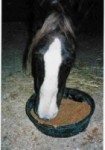 The bacteria that live in the hindgut need consistency. That’s why new feeds need to be introduced very slowly, taking a few weeks to completely switch over. A bran mash, or any feed for that matter, is unfamiliar to the hindgut microbial population and exposing them to it suddenly can trigger a dangerous colic attack. But there’s more to be concerned about, when it comes to feeding bran mashes.
The bacteria that live in the hindgut need consistency. That’s why new feeds need to be introduced very slowly, taking a few weeks to completely switch over. A bran mash, or any feed for that matter, is unfamiliar to the hindgut microbial population and exposing them to it suddenly can trigger a dangerous colic attack. But there’s more to be concerned about, when it comes to feeding bran mashes.
Many people feel that a bran mash helps as a laxative. Sure, the manure becomes softer but that’s because bran irritates the digestive lining, leading to softer manure. This indigestion causes poor absorption of nutrients. Furthermore, bran is very high in phosphorus – it has 10 times more phosphorus than calcium. When phosphorus exceeds calcium, it can lead to porous bones and poor muscle contraction/relaxation.
If you want to feed a warm bran mash during this winter, consistency is key – it must be fed every day, not once a week. Be sure to introduce it gradually and use a commercially fortified version that has added calcium to correct for its naturally inverted ratio.
For more information from Equine Nutritionist Expert, Dr Juliet Getty EEKLY BRAN MASHES ARE ASKING FOR TROUBLE!m



